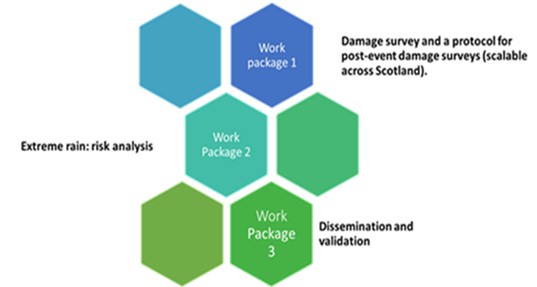Cultural Heritage and Urban Resilience in Scotland: Co-designing extreme rainfall impact assessment tools for adaptation
Published: 20 April 2022
Co-designing extreme rainfall impact assessment tools for adaptation - an NCR and Historic Environment Scotland (HES) funded project. Research carried out by a team from the University of Edinburgh.
Kate Crowley, YoungHwa Cha, Simon Tett and Gina Geffers
University of Edinburgh
This project provided a damage narrative for an extreme rainfall event on a heritage building and has developed the first template for post-event damage assessment to heritage buildings in Scotland. The research team carried out an in-depth survey of damage and loss incurred at Edinburgh Castle during an extreme rainfall event on 4th July 2021. A meteorological analysis of the rainfall event and future frequency and severity of extreme rainfall events, under a high emissions scenario, was also completed. Figure 1 provides a summary of the research design.

Figure 1: Project work packages. Work package 1 used interviews and a site visit to collect relevant damage and loss narratives, whilst work package 3 was delivered through two stakeholder workshops. Overall we implemented a co-design appraoch (Shaw et al. 2009)
|
Background/Context |
|
Scotland’s cities are currently vulnerable to extreme rainfall and flood events. However, we are uncertain how these events will change due to climate change and how our historic buildings will suffer. Currently resilience is undermined as adaptation is not keeping pace with rapidly changing risks (Climate Change Committee, 2021). |
|
There is no systematic way of recording post-event damage and loss information in Scotland for heritage sites and for creating critical scenarios for adaptation. This project has addressed this gap through a partnership with Historic Environment Scotland (HES).
|
Key findings highlighted the damage to the internal fabric of the castle in two key rooms, loss of staff hours and opportunity costs as well as near miss scenarios due to the significant influence of COVID 19 and the timing of the event itself. Rainfall radar data shows that the event was of very short duration and small scale. We estimate that such an event was approximately a 1-in-a-hundred year event and that a one-hour warning may have been possible. Using state-of-the-art climate models we estimate that the magnitude of 1-in-ten or 1-in-a-hundred year extreme rainfall events are likely to increase by about 15%, relative to the 1980-2000 norm, in the near term and by about 30% towards the end of the 21st century.
Damage Survey and Risk Pathway Scenarios: The interview outcomes are summarised in a damage and loss table. The interviewees also highlighted a number of ‘near-misses’. These near-miss narratives provide the basis for scenario development. Four risk pathways were produced: (Scenario A) baseline 2021 event; (Scenario B) longer duration of the extreme rainfall event; (Scenario C) the event occurred in winter (seasonal); (Scenario D) occurring during a normal busy festival peak summer time without COVID-19 measures.
Extreme rainfall analysis: In the future, the average rainfall is expected to decrease in summer and increase in winter. However, and very importantly, the intensity and occurrence of extreme rainfall events is expected to increase (Figure 2). This requires adaptation to accommodate such events, in particular with regards to damage that could, and is increasingly likely, to occur at Edinburgh Castle or similar cultural heritage sites in the future. We should take into account the science that supports the increased risk of such events on both people and infrastructure and use it for mitigation.

Figure 2: Mean seasonal maximum hourly rainfall in mm/hour for the baseline period (1980-2000). Values in the bottom right corner indicate the average rainfall for the region shown. For 2020-2040 and 2060-2080, the values indicate the percentage increase relative.
The project concluded that this type event is likely to increase in severity in summer and autumn months under high emission scenarios; the damage to the castle occurred due to insufficient drainage in crown square; the template can be used for the whole event life cycle. This rapid project developed a post-event damage survey template, risk pathway scenario tool and held workshops for Historic Environment Scotland and wider heritage sector partners.
|
Three Key Points/Implications/Next Steps from Research |
|
Staff believe that the template can be adopted to record, track and monitor response and recovery from a significant weather hazard event. Overcoming institutional memory loss and providing evidence for strategic decision making. |
|
The event analysis indicates the possibility for an early warning system to be co-developed between heritage agencies and the UK Met Office. |
|
The project should be scaled to examine a range of heritage types, develop quantitative functions for advanced impact modelling and the template integrated within existing property management systems with some basic training for relevant staff. |
|
References: Climate Change Committee. (2021). Independent Assessment of UK Climate Risk. Advice to Government For the UK’s third Climate Change Risk Assessment (CCRA3). Shaw, A., Sheppard, S., Burch, S., Flanders, D., Wiek, A., Carmichael, J., ... Cohen, S. (2009). Making local futures tangible—synthesizing, downscaling, and visualizing climate change scenarios for participatory capacity building. Global Environmental Change, 19, 447-463. |
The full report is available here.
This project was funded by the NCR and Historic Environment Scotland.
First published: 20 April 2022
<< Blog

